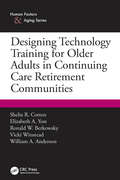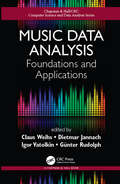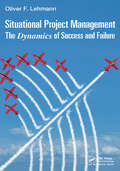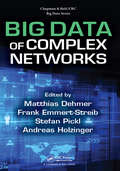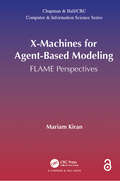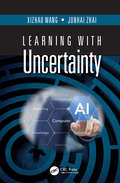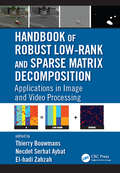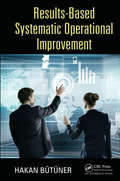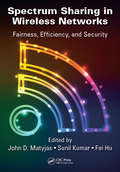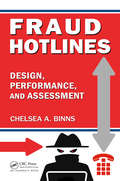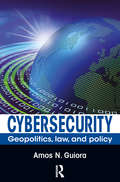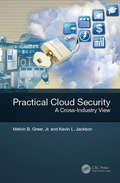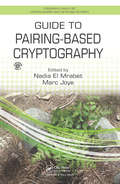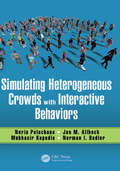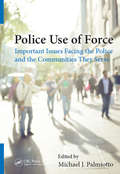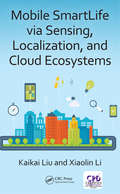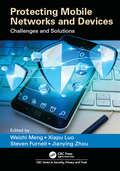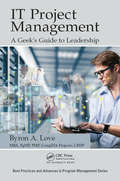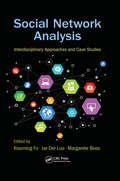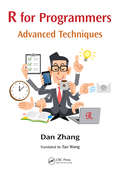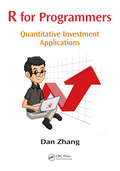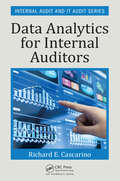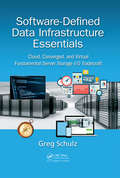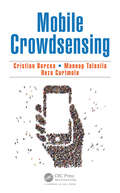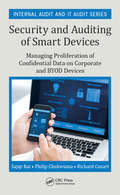- Table View
- List View
Designing Technology Training for Older Adults in Continuing Care Retirement Communities
by Shelia R. Cotten Elizabeth A. Yost Ronald W. Berkowsky Vicki Winstead William A. AndersonThis book provides the latest research and design-based recommendations for how to design and implement a technology training program for older adults in Continuing Care Retirement Communities (CCRCs). The approach in the book concentrates on providing useful best practices for CCRC owners, CEOs, activity directors, as well as practitioners and system designers working with older adults to enhance their quality of life. Educators studying older adults will also find this book useful Although the guidelines are couched in the context of CCRCs, the book will have broader-based implications for training older adults on how to use computers, tablets, and other technologies.
Music Data Analysis: Foundations and Applications (Chapman & Hall/CRC Computer Science & Data Analysis)
by Claus Weihs, Dietmar Jannach, Igor Vatolkin and Günter RudolphThis book provides a comprehensive overview of music data analysis, from introductory material to advanced concepts. It covers various applications including transcription and segmentation as well as chord and harmony, instrument and tempo recognition. It also discusses the implementation aspects of music data analysis such as architecture, user interface and hardware. It is ideal for use in university classes with an interest in music data analysis. It also could be used in computer science and statistics as well as musicology.
Situational Project Management: The Dynamics of Success and Failure (Best Practices in Portfolio, Program, and Project Management)
by Oliver F. LehmannMost project managers would agree that every project is unique. But not all project managers would agree that the best way to manage a unique project is unique. Many still cling to the old practice of having a methodology that is applied to all projects. "One size fits all" is still in common use, and this approach has proven to lead to project failure. Flexibility, situational intelligence, and creativity are essential to deliver project success. The need to recognize and master ever-changing requirements and environmental conditions is a tough challenge for professional project managers. The same practices that led to success yesterday may cause failure today. Selecting favorable responses to a given situation is often the most critical factor of the dynamics of success and failure. This book is designed to help project professionals assess a situation, predict the appropriate approach, methodology and achieving styles, and then apply them in a situational fashion. To guide project managers in selecting the appropriate responses, Situational Project Management (SitPM) shows how to assess a given project, determine its unique characteristics, and select the appropriate methods to complete the project. With this book, projects managers can use SitPM to develop profiles of their projects on the basis of the projects’ physical characteristics, the project teams’ behavioral characteristics, the enterprise environment, and the market environments receiving project deliverables. These profiles help project managers to determine the appropriate project life cycle approach and leadership style. The book also explores various ways to engage stakeholders on the basis of a project’s SitPM profile. The book’s author, Oliver F. Lehmann, has developed a set of templates to apply SitPM in practice. It can be downloaded from www.oliverlehmann.com/SitPM/Templates.zip.
Big Data of Complex Networks (Chapman & Hall/CRC Big Data Series)
by Matthias Dehmer, Frank Emmert-Streib, Stefan Pickl and Andreas HolzingerBig Data of Complex Networks presents and explains the methods from the study of big data that can be used in analysing massive structural data sets, including both very large networks and sets of graphs. As well as applying statistical analysis techniques like sampling and bootstrapping in an interdisciplinary manner to produce novel techniques for analyzing massive amounts of data, this book also explores the possibilities offered by the special aspects such as computer memory in investigating large sets of complex networks. Intended for computer scientists, statisticians and mathematicians interested in the big data and networks, Big Data of Complex Networks is also a valuable tool for researchers in the fields of visualization, data analysis, computer vision and bioinformatics. Key features: Provides a complete discussion of both the hardware and software used to organize big data Describes a wide range of useful applications for managing big data and resultant data sets Maintains a firm focus on massive data and large networks Unveils innovative techniques to help readers handle big data Matthias Dehmer received his PhD in computer science from the Darmstadt University of Technology, Germany. Currently, he is Professor at UMIT – The Health and Life Sciences University, Austria, and the Universität der Bundeswehr München. His research interests are in graph theory, data science, complex networks, complexity, statistics and information theory. Frank Emmert-Streib received his PhD in theoretical physics from the University of Bremen, and is currently Associate professor at Tampere University of Technology, Finland. His research interests are in the field of computational biology, machine learning and network medicine. Stefan Pickl holds a PhD in mathematics from the Darmstadt University of Technology, and is currently a Professor at Bundeswehr Universität München. His research interests are in operations research, systems biology, graph theory and discrete optimization. Andreas Holzinger received his PhD in cognitive science from Graz University and his habilitation (second PhD) in computer science from Graz University of Technology. He is head of the Holzinger Group HCI-KDD at the Medical University Graz and Visiting Professor for Machine Learning in Health Informatics Vienna University of Technology.
X-Machines for Agent-Based Modeling: FLAME Perspectives (Chapman & Hall/CRC Computer and Information Science Series)
by Mariam KiranFrom the Foreword: "This book exemplifies one of the most successful approaches to modeling and simulating [the] new generation of complex systems. FLAME was designed to make the building of large scale complex systems models straightforward and the simulation code that it generates is highly efficient and can be run on any modern technology. FLAME was the first such platform that ran efficiently on high performance parallel computers and a version for GPU technology is also available. At its heart, and the reason why it is so efficient and robust, is the use of a powerful computational model ‘Communicating X-machines’ which is general enough to cope with most types of modelling problems. As well as being increasingly important in academic research, FLAME is now being applied in industry in many different application areas. This book describes the basics of FLAME and is illustrated with numerous examples."—Professor Mike Holcombe, University of Sheffield, UK Agent-based models have shown applications in various fields such as biology, economics, and social science. Over the years, multiple agent-based modeling frameworks have been produced, allowing experts with non-computing background to easily write and simulate their models. However, most of these models are limited by the capability of the framework, the time it takes for a simulation to finish, or how to handle the massive amounts of data produced. FLAME (Flexible Large-scale Agent-based Modeling Environment) was produced and developed through the years to address these issues. This book contains a comprehensive summary of the field, covers the basics of FLAME, and shows how concepts of X-machines, can be stretched across multiple fields to produce agent models. It has been written with several audiences in mind. First, it is organized as a collection of models, with detailed descriptions of how models can be designed, especially for beginners. A number of theoretical aspects of software engineering and how they relate to agent-based models are discussed for students interested in software engineering and parallel computing. Finally, it is intended as a guide to developers from biology, economics, and social science, who want to explore how to write agent-based models for their research area. By working through the model examples provided, anyone should be able to design and build agent-based models and deploy them. With FLAME, they can easily increase the agent number and run models on parallel computers, in order to save on simulation complexity and waiting time for results. Because the field is so large and active, the book does not aim to cover all aspects of agent-based modeling and its research challenges. The models are presented to show researchers how they can build complex agent functions for their models. The book demonstrates the advantage of using agent-based models in simulation experiments, providing a case to move away from differential equations and build more reliable, close to real, models. The Open Access version of this book, available at https://doi.org/10.1201/9781315370729, has been made available under a Creative Commons Attribution-Non Commercial-No Derivatives 4.0 license.
Learning with Uncertainty
by Xizhao Wang Junhai ZhaiLearning with uncertainty covers a broad range of scenarios in machine learning, this book mainly focuses on: (1) Decision tree learning with uncertainty, (2) Clustering under uncertainty environment, (3) Active learning based on uncertainty criterion, and (4) Ensemble learning in a framework of uncertainty. The book starts with the introduction to uncertainty including randomness, roughness, fuzziness and non-specificity and then comprehensively discusses a number of key issues in learning with uncertainty, such as uncertainty representation in learning, the influence of uncertainty on the performance of learning system, the heuristic design with uncertainty, etc. <P><P>Most contents of the book are our research results in recent decades. The purpose of this book is to help the readers to understand the impact of uncertainty on learning processes. It comes with many examples to facilitate understanding. The book can be used as reference book or textbook for researcher fellows, senior undergraduates and postgraduates majored in computer science and technology, applied mathematics, automation, electrical engineering, etc.
Handbook of Robust Low-Rank and Sparse Matrix Decomposition: Applications in Image and Video Processing
by Thierry Bouwmans, Necdet Serhat Aybat and El-hadi ZahzahHandbook of Robust Low-Rank and Sparse Matrix Decomposition: Applications in Image and Video Processing shows you how robust subspace learning and tracking by decomposition into low-rank and sparse matrices provide a suitable framework for computer vision applications. Incorporating both existing and new ideas, the book conveniently gives you one-stop access to a number of different decompositions, algorithms, implementations, and benchmarking techniques. Divided into five parts, the book begins with an overall introduction to robust principal component analysis (PCA) via decomposition into low-rank and sparse matrices. The second part addresses robust matrix factorization/completion problems while the third part focuses on robust online subspace estimation, learning, and tracking. Covering applications in image and video processing, the fourth part discusses image analysis, image denoising, motion saliency detection, video coding, key frame extraction, and hyperspectral video processing. The final part presents resources and applications in background/foreground separation for video surveillance. With contributions from leading teams around the world, this handbook provides a complete overview of the concepts, theories, algorithms, and applications related to robust low-rank and sparse matrix decompositions. It is designed for researchers, developers, and graduate students in computer vision, image and video processing, real-time architecture, machine learning, and data mining.
Results-Based Systematic Operational Improvement
by Hakan ButunerThis book introduces Systematic Improvement Planning (SIP), a structured approach to improvement. It draws upon proven industrial engineering and quality improvement tools, along with some of its own, and enables people to make positive changes. SIP is designed to help meet goals, solve problems, and implement ideas. The book provides a comprehensive and detailed framework for operational improvement at all levels of an enterprise.
Spectrum Sharing in Wireless Networks: Fairness, Efficiency, and Security
by John D. Matyjas, Sunil Kumar and Fei HuSpectrum Sharing in Wireless Networks: Fairness, Efficiency, and Security provides a broad overview of wireless network spectrum sharing in seven distinct sections: The first section examines the big picture and basic principles, explaining the concepts of spectrum sharing, hardware/software function requirements for efficient sharing, and future trends of sharing strategies. The second section contains more than 10 chapters that discuss differing approaches to efficient spectrum sharing. The authors introduce a new coexistence and sharing scheme for multi-hop networks, describe the space-time sharing concept, introduce LTE-U, and examine sharing in broadcast and unicast environments. They then talk about different cooperation strategies to achieve mutual benefits for primary users (PU) and secondary users (SU), discuss protocols in a spectrum sharing context, and provide different game theory models between PUs and SUs. The third section explains how to model the interactions of PUs and SUs, using an efficient calculation method to determine spectrum availability. Additionally, this section explains how to use scheduling models to achieve efficient SU traffic delivery. The subject of the fourth section is MIMO-oriented design. It focuses on how directional antennas and MIMO antennas greatly enhance wireless network performance. The authors include a few chapters on capacity/rate calculations as well as beamforming issues under MIMO antennas. Power control is covered in the fifth section which also describes the interference-aware power allocation schemes among cognitive radio users and the power control schemes in cognitive radios. The sixth section provides a comprehensive look at security issues, including different types of spectrum sharing attacks and threats as well as corresponding countermeasure schemes. The seventh and final section covers issues pertaining to military applications and examines how the military task protects its data flows when sharing the spectrum with civilian applications.
Fraud Hotlines: Design, Performance, and Assessment
by Chelsea A. BinnsThis book provides a complete guide on fraud hotlines. It is designed to educate readers with respect to the history, purpose, operation, use and utility of fraud hotlines. It also equips readers with the knowledge to create, analyze and assess the performance of fraud hotlines.
Cybersecurity: Geopolitics, Law, and Policy
by Amos N. GuioraThis book examines the legal and policy aspects of cyber-security. It takes a much needed look at cyber-security from a geopolitical perspective. Through this lens, it seeks to broaden the reader's understanding of the legal and political considerations of individuals, corporations, law enforcement and regulatory bodies and management of the complex relationships between them. In drawing on interviews conducted with experts from a wide range of fields, the book presents the reader with dilemmas and paradigms that confront law makers, corporate leaders, law enforcement, and national leaders. The book is structured in a novel format by employing a series of vignettes which have been created as exercises intended to confront the reader with the dilemmas involved in cyber-security. Through the use of vignettes, the work seeks to highlight the constant threat of cyber-security against various audiences, with the overall aim of facilitating discussion and reaction to actual probable events. In this sense, the book seeks to provide recommendations for best practices in response to the complex and numerous threats related to cyber-security. This book will be of interest to students of cyber-security, terrorism, international law, security studies and IR in general, as well as policy makers, professionals and law-enforcement officials.
Practical Cloud Security: A Cross-Industry View
by Melvin B. Greer, Jr. Kevin L. JacksonMelvin Greer and Kevin Jackson have assembled a comprehensive guide to industry-specific cybersecurity threats and provide a detailed risk management framework required to mitigate business risk associated with the adoption of cloud computing. This book can serve multiple purposes, not the least of which is documenting the breadth and severity of the challenges that today’s enterprises face, and the breadth of programmatic elements required to address these challenges. This has become a boardroom issue: Executives must not only exploit the potential of information technologies, but manage their potential risks. Key Features • Provides a cross-industry view of contemporary cloud computing security challenges, solutions, and lessons learned • Offers clear guidance for the development and execution of industry-specific cloud computing business and cybersecurity strategies • Provides insight into the interaction and cross-dependencies between industry business models and industry-specific cloud computing security requirements
Guide to Pairing-Based Cryptography (Chapman & Hall/CRC Cryptography and Network Security Series)
by Nadia El Mrabet; Marc JoyeThis book is devoted to efficient pairing computations and implementations, useful tools for cryptographers working on topics like identity-based cryptography and the simplification of existing protocols like signature schemes. As well as exploring the basic mathematical background of finite fields and elliptic curves, Guide to Pairing-Based Cryptography offers an overview of the most recent developments in optimizations for pairing implementation. Each chapter includes a presentation of the problem it discusses, the mathematical formulation, a discussion of implementation issues, solutions accompanied by code or pseudocode, several numerical results, and references to further reading and notes. Intended as a self-contained handbook, this book is an invaluable resource for computer scientists, applied mathematicians and security professionals interested in cryptography.
Simulating Heterogeneous Crowds with Interactive Behaviors
by Nuria Pelechano, Jan M. Allbeck, Mubbasir Kapadia and Norman I. BadlerThis book provides a deep understanding of state-of-art methods for simulation of heterogeneous crowds in computer graphics. It will cover different aspects that are necessary to achieve plausible crowd behaviors. The book will be a review of the most recent literature in this field that can help professionals and graduate students interested in this field to get up to date with the latest contributions, and open problems for their possible future research. The chapter contributors are well known researchers and practitioners in the field and they include their latest contributions in the different topics required to achieve believable heterogeneous crowd simulation. Provides crowd simulation methodology to populate virtual environments, for video games or any kind of applications that requires believable multi-agent behavior Presents the latest contributions on crowd simulation, animation, planning, rendering and evaluation with detailed algorithms for implementation purposes Includes perspectives of both academic researchers and industrial practitioners with reference to open source solutions and commercial applications, where appropriate
Police Use of Force: Important Issues Facing the Police and the Communities They Serve
by Michael J. PalmiottoStarting with a historical introduction, Police Use of Force presents readers with critical and timely issues facing police and the communities they serve when police encounters turn violent. Dr. Palmiotto offers in-depth coverage of the use of force, deadly force, non-lethal weapons, militarization of policing, racism and profiling, legal cases, psychology, perception and training, and violence prevention. Police Use of Force also investigates many case studies, both famous (Rodney King) and contemporary (Ferguson, MO). Essential reading for both criminal justice professionals and academics, this text places police conflict within a complex, modern context, inviting cogent conversation in the classroom and the precinct.
Mobile SmartLife via Sensing, Localization, and Cloud Ecosystems
by Kaikai Liu Xiaolin LiIndoor location is one of the two most important contexts (time and location), becoming a key entry for mobile Internet. This book envisions potential indoor location applications, overviews the related state of the art technologies, and presents original patented techniques and open source prototype systems. The tutorial and sample code are provided as a good reference and starting point for readers who are interested in the technique detail.
Protecting Mobile Networks and Devices: Challenges and Solutions (Series in Security, Privacy and Trust)
by Steven Furnell Jianying Zhou Xiapu Luo Weizhi MengThis book gathers and analyzes the latest attacks, solutions, and trends in mobile networks. Its broad scope covers attacks and solutions related to mobile networks, mobile phone security, and wireless security. It examines the previous and emerging attacks and solutions in the mobile networking worlds, as well as other pertinent security issues. The many attack samples present the severity of this problem, while the delivered methodologies and countermeasures show how to build a truly secure mobile computing environment.
IT Project Management: A Geek's Guide to Leadership (Best Practices in Portfolio, Program, and Project Management)
by Byron A. LoveThis book’s author, Byron Love, admits proudly to being an IT geek. However, he had found that being an IT geek was limiting his career path and his effectiveness. During a career of more than 31 years, he has made the transition from geek to geek leader. He hopes this book helps other geeks do the same. This book addresses leadership issues in the IT industry to help IT practitioners lead from the lowest level. Unlike other leadership books that provide a one-size-fits-all approach to leadership, this book focuses on the unique challenges that IT practitioners face. IT project managers may manage processes and technologies, but people must be led. The IT industry attracts people who think in logical ways—analytical types who have a propensity to place more emphasis on tasks and technology than on people. This has led to leadership challenges such as poor communication, poor relationship management, and poor stakeholder engagement. Critical IT projects and programs have failed because IT leaders neglect the people component of "people, process, and technology." Communications skills are key to leadership. This book features an in-depth discussion of the communications cycle and emotional intelligence, providing geek leaders with tools to improve their understanding of others and to help others understand them. To transform a geek into a geek leader, this book also discusses: Self-leadership skills so geek leaders know how to lead others by leading themselves first Followership and how to cultivate it among team members How a geek leader’s ability to navigate disparate social styles leads to greater credibility and influence Integrating leadership into project management processes The book concludes with a case study to show how to put leadership principles and practices into action and how an IT geek can transform into an effective IT geek leader.
Social Network Analysis: Interdisciplinary Approaches and Case Studies
by Xiaoming Fu; Jar-Der Luo; Margarete BoosThe book addresses the issue of interdisciplinary understanding of collaboration on the topic of social network studies. Researchers and practitioners from various disciplines including sociology, computer science, socio-psychology, public health, complex systems, and management science have worked largely independently, each with quite different principles, terminologies, theories. and methodologies. The book aims to fill the gap among these disciplines with a number of the latest interdisciplinary collaboration studies.
R for Programmers: Advanced Techniques
by Dan ZhangThis book discusses advanced topics such as R core programing, object oriented R programing, parallel computing with R, and spatial data types. The author leads readers to merge mature and effective methdologies in traditional programing to R programing. It shows how to interface R with C, Java, and other popular programing laguages and platforms.
R for Programmers: Quantitative Investment Applications
by Dan ZhangAfter the fundamental volume and the advanced technique volume, this volume focuses on R applications in the quantitative investment area. Quantitative investment has been hot for some years, and there are more and more startups working on it, combined with many other internet communities and business models. R is widely used in this area, and can be a very powerful tool. The author introduces R applications with cases from his own startup, covering topics like portfolio optimization and risk management.
Data Analytics for Internal Auditors (Security, Audit and Leadership Series #9)
by Richard E. CascarinoThere are many webinars and training courses on Data Analytics for Internal Auditors, but no handbook written from the practitioner’s viewpoint covering not only the need and the theory, but a practical hands-on approach to conducting Data Analytics. The spread of IT systems makes it necessary that auditors as well as management have the ability to examine high volumes of data and transactions to determine patterns and trends. The increasing need to continuously monitor and audit IT systems has created an imperative for the effective use of appropriate data mining tools. This book takes an auditor from a zero base to an ability to professionally analyze corporate data seeking anomalies.
Software-Defined Data Infrastructure Essentials: Cloud, Converged, and Virtual Fundamental Server Storage I/O Tradecraft
by Greg SchulzSoftware-Defined Data Infrastructures Essentials provides fundamental coverage of physical, cloud, converged, and virtual server storage I/O networking technologies, trends, tools, techniques, and tradecraft skills. From webscale, software-defined, containers, database, key-value store, cloud, and enterprise to small or medium-size business, the book is filled with techniques, and tips to help develop or refine your server storage I/O hardware, software, and services skills. Whether you are new to data infrastructures or a seasoned pro, you will find this comprehensive reference indispensable for gaining as well as expanding experience with technologies, tools, techniques, and trends. We had a front row seat watching Greg present live in our education workshop seminar sessions for ITC professionals in the Netherlands material that is in this book. We recommend this amazing book to expand your converged and data infrastructure knowledge from beginners to industry veterans. —Gert and Frank Brouwer, Brouwer Storage Consultancy Software-Defined Data Infrastructures Essentials provides the foundational building blocks to improve your craft in serval areas including applications, clouds, legacy, and more. IT professionals, as well as sales professionals and support personnel, stand to gain a great deal by reading this book.—Mark McSherry, Oracle Regional Sales Manager Looking to expand your data infrastructure IQ? From CIOS to operations, sales to engineering, this book is a comprehensive reference, a must read for IT infrastructure professionals, beginners to seasoned experts.—Tom Becchetti, Advisory Systems Engineer Greg Schulz has provided a complete ‘toolkit’ for storage management along with the background and framework for the storage or data infrastructure professional or those aspiring to become one.—Greg Brunton, Experienced Storage and Data Management Professional
Mobile Crowdsensing
by Cristian Borcea Manoop Talasila Reza CurtmolaMobile crowdsensing is a technology that allows large scale, cost-effective sensing of the physical world. In mobile crowdsensing, mobile personal devices such as smart phones or smart watches come equipped with a variety of sensors that can be leveraged to collect data related to environment, transportation, healthcare, safety and so on. This book presents the first extensive coverage of mobile crowdsensing, with examples and insights drawn from the authors’ extensive research on this topic as well as from the research and development of a growing community of researchers and practitioners working in this emerging field. Throughout the text, the authors provide the reader with various examples of crowdsensing applications and the building blocks to creating the necessary infrastructure, explore the related concepts of mobile sensing and crowdsourcing, and examine security and privacy issues introduced by mobile crowdsensing platforms. Provides a comprehensive description of mobile crowdsensing, a one-stop shop for all relevant issues pertaining to mobile crowdsensing, including motivation, applications, design and implementation, incentive mechanisms, and reliability and privacy. Describes the design and implementations of mobile crowdsensing platforms of great interest for the readers working in research and industry to quickly implement and test their systems. Identifies potential issues in building such mobile crowdsensing applications to ensure their usability in real life and presents future directions in mobile crowdsensing by emphasizing the open problems that have to be addressed.
Security and Auditing of Smart Devices: Managing Proliferation of Confidential Data on Corporate and BYOD Devices (Security, Audit and Leadership Series)
by Sajay Rai Philip Chukwuma Richard CozartMost organizations have been caught off-guard with the proliferation of smart devices. The IT organization was comfortable supporting the Blackberry due to its ease of implementation and maintenance. But the use of Android and iOS smart devices have created a maintenance nightmare not only for the IT organization but for the IT auditors as well. This book will serve as a guide to IT and Audit professionals on how to manage, secure and audit smart device. It provides guidance on the handling of corporate devices and the Bring Your Own Devices (BYOD) smart devices.
